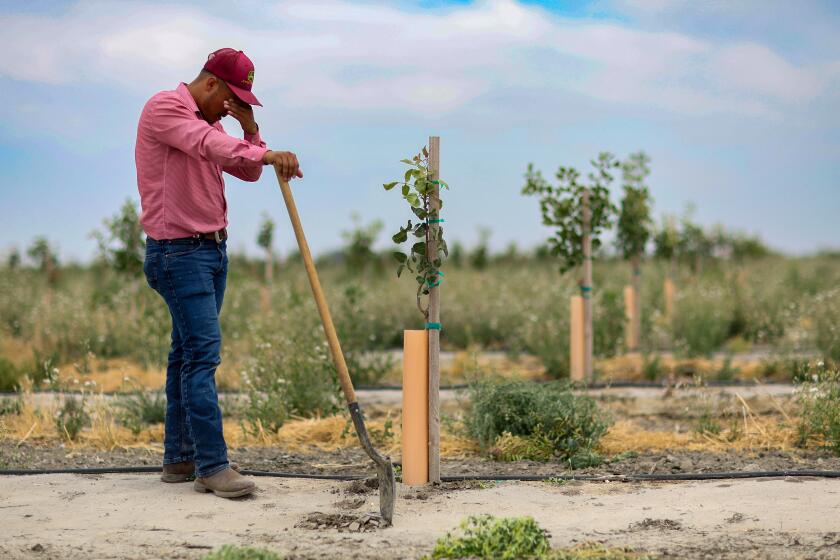Trial to Focus on Police Tactics at Santa Ana Bar : Courts: Owner alleges officers singled out her customers, most of whom are Mexican immigrants, for harassment.
To Elba Freeman, the Red Turtle is a bar where customers can listen to ranchera music, play pool and have a few beers away from their small and often overcrowded apartments.
But to vice officers, Freeman’s bar in a strip mall on the 1000 block of South Fairview Street, is not an innocent retreat but a haven for drug dealers and buyers.
A trial beginning today in U.S. District Court will focus on how police have dealt with the bar and its customers, most of whom are Mexican immigrants. The outcome, Freeman’s attorneys say, may affect future law enforcement policies from the handling of raids and arrests to the way officers act in racially diverse communities.
The lawsuit, brought by Freeman five years ago against the city of Santa Ana and its police force, alleges that police singled out her customers for harassment on the basis of race. Police raided the bar in 1987 and 1988 and, without a warrant, searched every customer, made illegal seizures and dropped customers’ pants in public to search them, the lawsuit alleges.
“A jury decision against such mass raids would send a clear reaffirmation that this kind of police action is not permissible,” said Meir J. Westreich, an attorney for Freeman.
Defense lawyer A.J. Pyka and police officers refused to comment on the case, but some law enforcement officials said shootings and narcotics sales around the bar demanded harsh measures.
One investigator for the state Department of Alcoholic Beverage Control said of the Red Turtle: “You go in there and you’re going to see certain things you just won’t see in other places.”
A 22-year-old man was fatally shot outside the bar in 1987, and police said another man the same age died when his throat was slashed in a bar fight in 1989.
ABC investigators compiled a list of 86 alleged crimes at the bar between 1986 and 1991, ranging from murder to prostitution. But an administrative judge who reviewed those reports found Freeman not liable, because she had not been involved in any of the incidents and had tried to combat the crime problem.
Santa Ana Police Lt. Robert Helton said the severity of a crime problem, not race, dictates the measures police use against it.
“There isn’t any situation where we would treat anybody any different than anyone else,” Helton said.
Lawyers for the city and eight police officials named in the lawsuit, including former Police Chief Clyde L. Cronkhite and current Chief Paul M. Walters, say in court papers that the raids were within the officers’ duty.
Freeman’s attorneys admit there have been serious crime problems around the bar. That does justify mistreatment of customers, they said.
“Unfortunately, poor people usually live in high crime areas. Does that mean they don’t have the right to go to happy hours?” Westreich asked.
Freeman said most of her customers are factory workers, busboys or other low-income workers.
“Like in every business, you have the good and the bad,” Freeman said. “But most of these people are good people.”
Freeman said police harassment began after 1985, when she filed a complaint alleging that Officer Steven Lodge pushed her and used foul language during a routine bar check. He served a four-hour suspension for the incident.
The ABC then began its investigation, the lawsuit alleges, and police issued seven other misdemeanor citations against the bar.
Freeman’s lawyers, however, are most upset about the drug raids in late 1987 and mid-1988.
Michael J. Cisarik, one of Freeman’s attorneys, showed a surveillance video of a 1987 raid in which an officer cocked a shotgun and announced “ policia !” as other officers followed behind. Police lined up customers at the bar and searched their pockets.
To conduct such a search, Cisarik said, police must have a person’s consent, suspicion that a specific person possesses an illegal substance, or specific information that a person may pose a threat to an officer.
In May, 1988, Freeman gave other surveillance tapes to police to help them identify and arrest drug dealers, according to the lawsuit. Two weeks later police and members of the ABC’s now-defunct Drug Enforcement-Narcotics Team made several undercover drug buys at the Red Turtle and then raided it.
But officers entered without warrants, Westreich said. They searched all customers for drugs, dropped several customers’ pants to search them, and seized a surveillance tape that was running that night, the lawsuit alleges.
An internal Santa Ana police investigation memo states that when “officers entered the bar they had no knowledge as to who the suspects were, and since there were 30 to 35 people inside, it was necessary for officer safety to pat down everyone for weapons.” The memo also stated no warrant was necessary, and it deemed Freeman’s allegations unfounded.
But Cisarik said: “Even if they say it was for officer safety, that doesn’t allow you to drop people’s pants, freeze the bar, kick in an office door and remove a tape.”
Police arrested 10 people on suspicion of drug violations during the raid and seized more than 200 packets of cocaine and tar heroin.
But Cisarik said crime statistics support the lawsuit’s claim that Latino bars have been singled out. Between 1986 and 1990, police reported 345 criminal incidents at the Red Turtle. For comparison, the Red Onion--which lawyers characterized as a primarily white bar--had 316 criminal incidents those five years. Yet police did not target the Red Onion or other non-immigrant bars for raids, Cisarik said.
“They don’t do mass raids, where they take everybody and put them up against the wall, in Anglo bars,” Westreich said.
The Santa Ana City Council approved a resolution in 1990 to cover any payments the officers may incur in the case if the city loses the suit.
“The officers were really concerned about paying punitive damages,” said City Atty. Edward J. Cooper. Governmental bodies do not have to pay for damages, but they may “if the officers were acting in good faith and in the best interest of the city.”
“We took a close look at all the facts known to us and it appeared the officers were doing their jobs in this case,” Cooper said.
More to Read
Sign up for Essential California
The most important California stories and recommendations in your inbox every morning.
You may occasionally receive promotional content from the Los Angeles Times.






